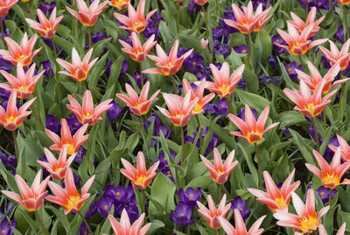Kaufmanniana Tulips, Waterlily Tulips, Spring Bulbs, Spring Flowers
Have you ever seen Kaufmanniana Tulips? If you have, no doubt you planted them in your garden or your containers.
.jpeg) |
 |
A symbol of spring, tulips are the most popular spring bulbs; most gardeners reserve them a spot in the garden or in containers. Grown for their attractive, vibrantly colored flowers, there are currently over 3,000 registered varieties, divided into fifteen groups, mostly based on the tulip’s flower type, size, and blooming period.
| Hardiness |
3 - 8 |
|---|---|
| Heat Zones |
1 - 8 |
| Climate Zones | 1, 2, 3, 4, 5, 6, 7, 8, 9, 10, 11, 12, 13, 14, 15, 16, 17, 18, 19, 20, 21, 22, 23, 24 |
| Plant Type | Bulbs |
| Genus | Tulipa |
| Exposure | Full Sun |
| Season of Interest |
Spring (Early) |
| Height |
6" - 1' (15cm - 30cm) |
| Spread | 4" (10cm) |
| Spacing | 4" (10cm) |
| Depth | 7" (18cm) |
| Maintenance | Low |
| Water Needs | Average |
| Soil Type | Chalk, Loam, Sand |
| Soil pH | Acid, Alkaline, Neutral |
| Soil Drainage | Well-Drained |
| Characteristics | Cut Flowers, Showy |
| Tolerance | Deer, Rabbit |
| Landscaping Ideas | Beds And Borders, Patio And Containers, Edging |
| Garden Styles | City and Courtyard, Gravel and Rock Garden, Informal and Cottage |
/ 123RF Stock Photo
| Hardiness |
3 - 8 |
|---|---|
| Heat Zones |
1 - 8 |
| Climate Zones | 1, 2, 3, 4, 5, 6, 7, 8, 9, 10, 11, 12, 13, 14, 15, 16, 17, 18, 19, 20, 21, 22, 23, 24 |
| Plant Type | Bulbs |
| Genus | Tulipa |
| Exposure | Full Sun |
| Season of Interest |
Spring (Early) |
| Height |
6" - 1' (15cm - 30cm) |
| Spread | 4" (10cm) |
| Spacing | 4" (10cm) |
| Depth | 7" (18cm) |
| Maintenance | Low |
| Water Needs | Average |
| Soil Type | Chalk, Loam, Sand |
| Soil pH | Acid, Alkaline, Neutral |
| Soil Drainage | Well-Drained |
| Characteristics | Cut Flowers, Showy |
| Tolerance | Deer, Rabbit |
| Landscaping Ideas | Beds And Borders, Patio And Containers, Edging |
| Garden Styles | City and Courtyard, Gravel and Rock Garden, Informal and Cottage |
Create a membership account to save your garden designs and to view them on any device.
Becoming a contributing member of Gardenia is easy and can be done in just a few minutes. If you provide us with your name, email address and the payment of a modest $25 annual membership fee, you will become a full member, enabling you to design and save up to 25 of your garden design ideas.
Join now and start creating your dream garden!
Create a membership account to save your garden designs and to view them on any device.
Becoming a contributing member of Gardenia is easy and can be done in just a few minutes. If you provide us with your name, email address and the payment of a modest $25 annual membership fee, you will become a full member, enabling you to design and save up to 25 of your garden design ideas.
Join now and start creating your dream garden!